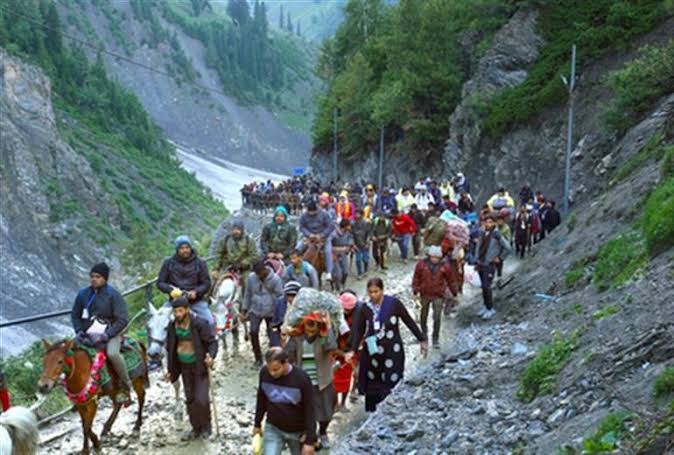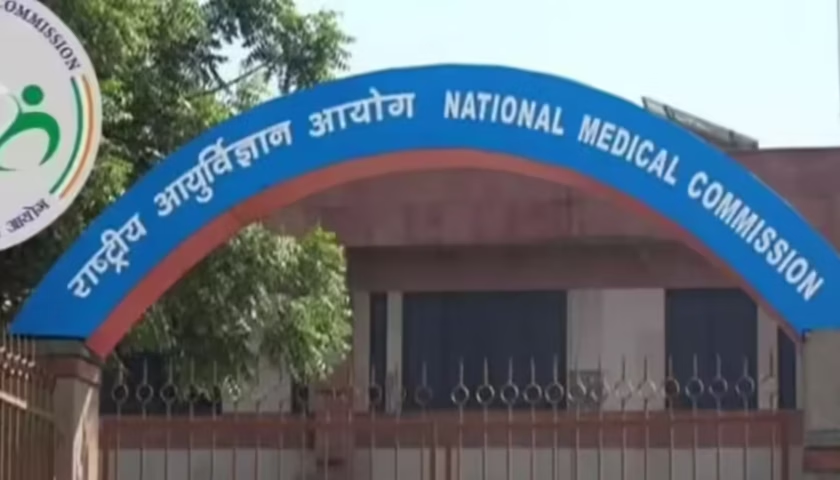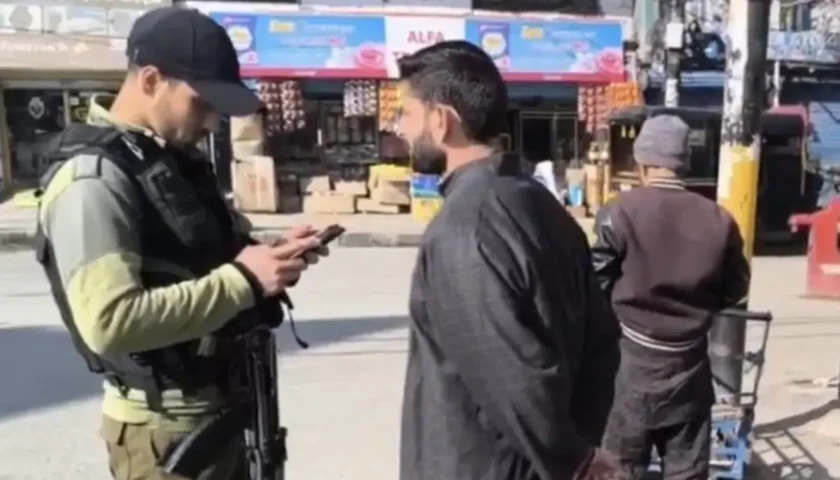Amarnath Yatra 2025 Traffic Advisory: Safety First or a Journey of Disruptions?
By: Javid Amin | Srinagar | 02 July 2025
The Sacred Journey Meets Practical Planning
The annual Amarnath Yatra, a deeply spiritual journey for lakhs of devotees who brave the Himalayan terrain to pay obeisance at the holy cave of Lord Shiva, is not just a religious pilgrimage—it’s a massive logistical event. From medical teams and military deployment to shelter, food, and most importantly, traffic management, the smooth conduct of the yatra depends on microscopic planning.
For the 2025 season, the Jammu and Kashmir Traffic Police has released an extensive traffic advisory to regulate the movement of pilgrims, tourists, and commercial vehicles. This guide outlines strict cut-off timings, route conditions, mandatory ID checks, and restrictions on heavy motor vehicles (HMVs) to minimize risk and ensure smooth travel.
While these measures are rooted in public safety and coordination, they also bring forth certain challenges—frustrations, logistical hurdles, and regional imbalances.
In this detailed report, we explore:
-
The official directives in the Amarnath Yatra 2025 traffic advisory
-
Route restrictions and timing protocols
-
The rationale behind the rules
-
The impact on pilgrims, locals, transporters, and tourism
-
The infrastructural bottlenecks still haunting NH-44
-
What needs to improve for a safer and less stressful pilgrimage
Why Traffic Management Is Crucial for Amarnath Yatra
Every year, over half a million pilgrims undertake the yatra to Amarnath cave, located 3,888 meters above sea level. The journey involves travel through some of the most volatile and dangerous terrain in Jammu & Kashmir, especially along the Jammu–Srinagar National Highway (NH-44), which is prone to landslides, shooting stones, flash floods, and narrow choke points.
Given these realities, managing traffic is not just about convenience—it’s a matter of life and death. The 2025 advisory attempts to streamline this process, but also reveals deeper cracks in the region’s travel infrastructure.
Cut-Off Timings: Strict Windows, Zero Flexibility
Cut-off Timings for Passenger Vehicles on July 2
-
Nagrota (Jammu) to Srinagar: 6:00 AM – 12:00 PM
-
Jakheni (Udhampur) to Srinagar: 7:00 AM – 1:00 PM
-
Qazigund to Jammu: 11:30 AM – 2:00 PM
No vehicle—pilgrim or otherwise—will be allowed to move outside these windows. This level of rigidity has a clear goal: prevent late-night travel in landslide-prone zones. However, it also comes with its own set of complications.
The Flip Side
-
Pilgrims who miss the cut-off lose a full day, resulting in overcrowded shelters and strain on accommodation facilities.
-
Local transporters and hotel operators complain of a sudden drop in last-minute or late-arriving tourist traffic, hitting their revenue.
-
Emergency situations (like vehicle breakdowns or health issues) become logistical nightmares when travelers are caught between check-posts post cut-off.
This hard enforcement is seen by some as necessary discipline, while others call it inflexible red tape.
Heavy Motor Vehicles (HMVs): Partial Movement, Major Restrictions
HMV Protocols for July 2025
-
HMVs permitted from Jakheni (Udhampur) to Srinagar, but based on live weather and traffic updates.
-
No HMV movement allowed after 7:00 PM.
-
Essential goods vehicles like fuel, LPG, and FCI supplies must return via Mughal Road, avoiding NH-44.
This redirection is meant to ease congestion and prioritize pilgrim traffic on the main highway. However, the Mughal Road, while scenic and less busy, isn’t fully reliable—especially under rainfall or landslide conditions.
The Negative Impact
-
Transporters claim they are forced to take longer, riskier detours, leading to rising fuel costs and delivery delays.
-
Essential services in towns along NH-44 may experience supply disruptions due to the re-routing of goods traffic.
-
There’s a lack of monitoring and support infrastructure on Mughal Road, making it less secure for heavy-load transit.
Route Conditions: Ramban–Banihal Still a Bottleneck
The advisory warns of single-lane traffic and shooting stone risks between Ramban and Banihal, one of the most notorious stretches on NH-44. Despite multiple highway development projects over the past decade, this section remains a symbol of underdevelopment and poor crisis management.
What the Advisory Says
-
Travel during daylight hours only is strongly recommended.
-
Only roadworthy, properly loaded, and fueled vehicles will be allowed to pass.
The Harsh Reality
-
Frequent closures due to even minor rains disrupt the entire Yatra movement.
-
Inadequate alternate routes mean there is no Plan B when NH-44 is blocked.
-
Poor road engineering and slope stabilization continue to endanger lives.
Locals and travelers alike are baffled that a road so critical to both pilgrimage and economy remains in such a fragile state.
ID Requirements & Regional Access
After cut-off hours, only residents of specific districts (Reasi, Katra, Udhampur, Patnitop, Doda, and Ramban) are allowed to travel—with valid photo identification. This measure is in place to distinguish local commuters from Yatra or tourist vehicles.
Positives
-
Helps reduce non-essential travel during critical time windows.
-
Allows local residents some flexibility to carry on daily life despite the Yatra influx.
Negatives
-
Pilgrims or tourists unaware of the rule get stranded without shelter or assistance.
-
Borderline cases (e.g., hotel staff commuting from one town to another) often get stuck at check-points, harming local businesses.
-
No clarity on ID verification methods leads to inconsistencies at police posts.
Goods and Perishable Carriers: Ticking Clocks and Tight Rules
The advisory mandates that perishable and essential goods carriers follow strict movement rules:
-
Must load from NAVYUG Tunnel to Levdoora before 9:00 AM.
-
Only 6- or 10-tyre HMVs are allowed on Dhar Road.
These policies aim to protect supply chains while minimizing larger HMV disruptions on pilgrim routes.
But Are They Working?
-
Vendors supplying langars (free food stalls) complain of spoilage due to delays.
-
Local farmers, especially fruit sellers, face economic losses if they miss the limited loading window.
-
Dhar Road itself has limited capacity, making it unsuitable for scaling up under pressure.
Coordinated Yet Strained: Traffic Control Units’ Role
The 2025 advisory is the result of joint coordination between Traffic Control Units (TCUs) in Jammu, Srinagar, and Ramban. The synergy is visible in how well the communication flows on the ground, and digital updates via mobile apps or highway announcements have improved.
But the efficacy of these units is undermined by outdated hardware, insufficient personnel, and lack of live weather monitoring systems.
What’s Missing: Suggestions for Smarter Yatra Management
Despite the precautions, the Amarnath Yatra traffic advisory lacks several key support systems that could significantly improve the experience:
1. Real-Time Pilgrim Tracking
-
A mobile app that gives pilgrims real-time updates on cut-offs, route closures, and weather alerts.
2. Emergency Passes & Medical Exemptions
-
For pilgrims with senior citizens or health issues, special clearances during emergencies should be automated and fast-tracked.
3. Alternate Route Readiness
-
Mughal Road and Dhar Road need infrastructure upgrades to handle diverted traffic more safely.
4. More Transit Shelters
-
Establish shelters near major choke points like Ramban, Banihal, and Qazigund with washrooms, food, and medical facilities.
Bottom-Line: Smooth Conduct or A System Under Stress?
The Amarnath Yatra 2025 Traffic Advisory is a step in the right direction—a well-structured attempt to manage an enormous religious event through coordinated logistics and safety enforcement. But while it showcases control and caution, it also exposes deep-rooted problems in Jammu & Kashmir’s transport infrastructure and crisis readiness.
The balance between discipline and disruption is delicate. On one hand, pilgrims are safer; on the other, they’re also more restricted, often left at the mercy of rigid timelines and unpredictable road conditions.
For the yatra to truly embody both spiritual serenity and logistical smoothness, the future must include smarter tech, better roads, real-time monitoring, and human-centered planning.
Because while faith moves the devotees, it’s systems that must move the journey.




